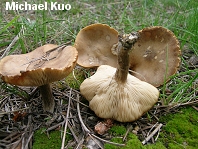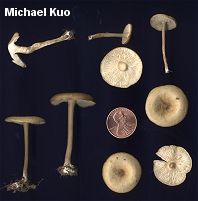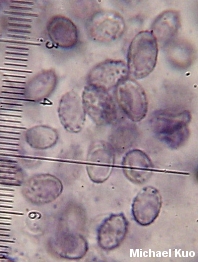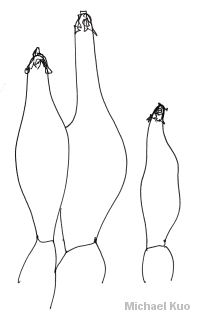| Major Groups > Gilled Mushrooms > Pale-Spored > Melanoleuca |

|
The Genus Melanoleuca [ Basidiomycetes > Agaricales > Tricholomataceae . . . ] by Michael Kuo I mean no disrespect to anyone whose studies are devoted to Melanoleuca, but I find these mushrooms to be tedious. Most of them are small to medium-sized, brownish to whitish things with few distinctive features (even the harpoon-like, microscopic cystidia get boring after one or two views), and identifying them is nearly as tedious as singing Suzanne Vega's "My Name is Luka" with the words changed to "Melanoleuca" turns out to be after the first couple of times. Most Melanloleucas can be identified to genus without recourse to microscopic examination, through a combination of features:
Larger species can be confused with Tricholoma, but one peek at the spores will clear up confusion; the spores in Melanoleuca are ornamented with amyloid warts. Leucopaxillus, which also has amyloid, warty spores, can usually be eliminated because species of Melanoleuca do not feature copious mycelium attached to the stem base, or gills that "do the Leucopaxillus thing" (see the linked page). Literature for Melanoleuca in North America is almost non-existent. Beyond field guide treatments, I am aware of only one paper (Gillman & Miller, 1977), now 30 years old, devoted only to boreal and montane species--and a study (Pfister, 1984) of the 131 species of Melanoleuca described by Peck and Murrill, whose concept of the genus predated the contemporary definition requiring spores with amyloid ornamentation, finding only six of the 131 taxa to be true Melanoleucas. But I admit that my literature search was not thorough, since I quickly tired of attempting to limit results in biology databases when "melanoleuca" produced thousands of returns, including pages and pages of references to papers on the semen of pandas. If you have more patience than I do, you will need to ask your database to eliminate results that include "ailuropoda" (Ailuropoda melanoleuca is a panda), "tringa" (Tringa melanoleuca appears to be a shore bird called "yellowlegs"), "naja" (Naja melanoleuca is a "black forest cobra")--and probably many other terms, since melanoleuca is obviously a popular taxonomic name. The species names used for North American Melanoleucas, with a few exceptions, are European names approached with a "best fit" attitude, and all North American Melanoleuca identifications should be viewed as tentative, awaiting a thorough study of the genus on our continent (see the comments under "Melanoleuca melaleuca" for more information). |
© MushroomExpert.Com |




